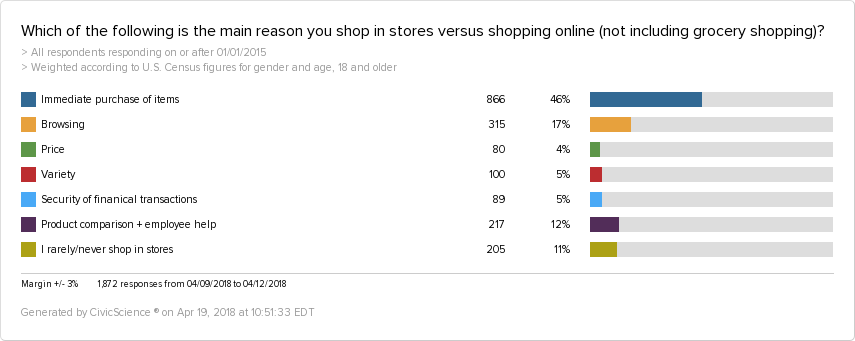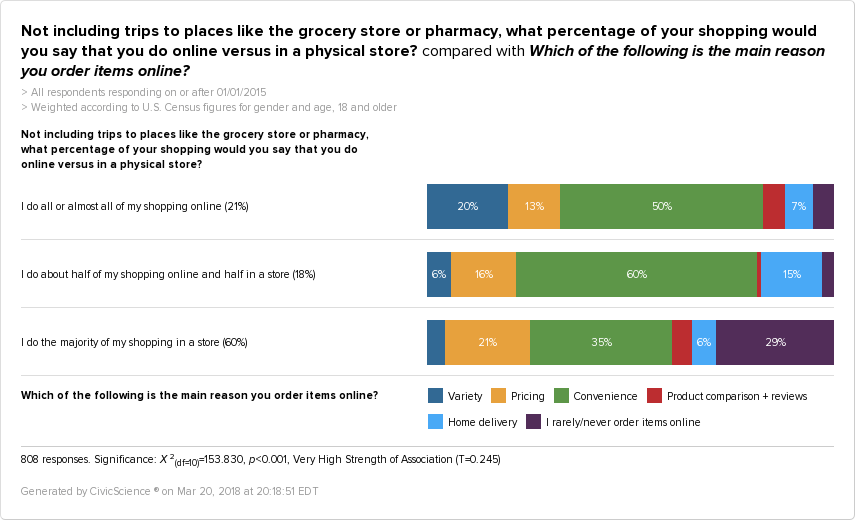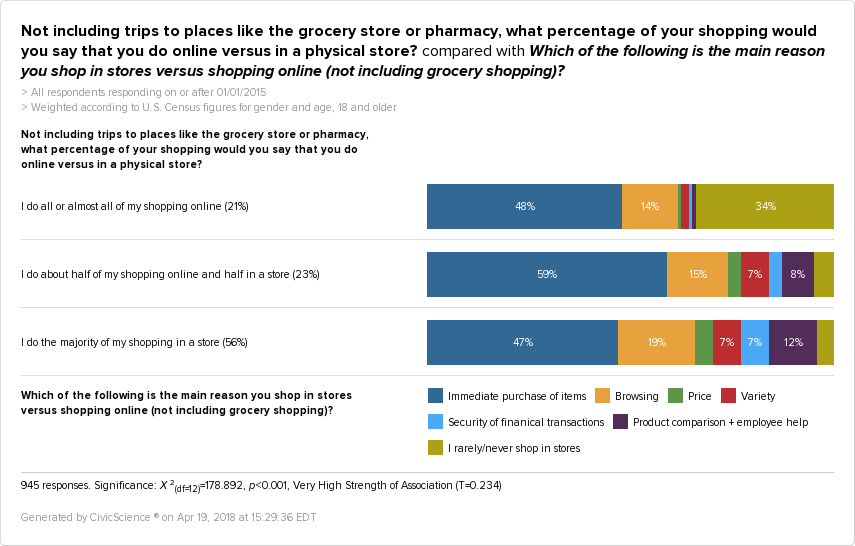The Gist: Online shopping has disrupted the livelihood of brick-and-mortars, but the convenience of making immediate purchases and browsing are leading reasons Americans continue to shop more in-store than online. In fact, 59% of U.S. adults say they do the majority of their non-grocery and pharmacy shopping in a physical store.
You’re on your way home from work when you remember you’re out of garbage bags, so you head to the nearest Target.
While you’re there, you pick up some other items that you’ve forgotten, including a new USB cord for your phone. Maybe you can find a better deal online, you think. You’re in a rush, so you throw it in the basket and head to checkout.
If this sounds like you, you’re not alone. In fact, nearly half of U.S. adults say that being able to purchase items immediately is the main reason why they continue to shop in -stores for retail goods versus shopping online:
Consider that the majority (59%) of U.S. adults shop more in-store than online, and it becomes clear that the immediate purchase of items is an important component of U.S. retail.
That may not exactly be surprising; immediate gratification is basically part of our cultural identity, for better or worse. Fast food, anyone?
But it seems that e-commerce has thrown a monkey-wrench into the machine and is challenging what “convenience” means to different people.
The battle of conveniences: it’s not just about speed.
43% of people say convenience is the main reason they shop online; outweighing other categories, like price, delivery, variety, and product comparison. (We cover this more in-depth in a previous post.)
So it seems convenience is in the eye of the consumer. Both in-store and online shoppers cite convenience as a top reason for where they choose to shop.
However, convenience doesn’t equate to complete loyalty to a single mode of shopping. Of the 60% of people who do more shopping in-store than online, only 29% say they “rarely or never order items online.” That means the other 71% of loyal in-store shoppers are also buying retail items online:
On the flip side, when we look at the same cross-section compared with reasons for shopping in-stores, we see that 66% of loyal online shoppers still shop in-store. Only 34% say they rarely or never set foot in a store.
The majority of the population still shops both online and in-store, with varying frequency and for different reasons. Convenience — whether that’s in the context of online shopping or the immediate purchases of in-store shopping — is the leading factor for both experiences.
Stores are losing price-conscious shoppers to online retailers.
Convenience is important for all shoppers, but let’s not overlook price. Our data shows it’s the second-most important reason why people shop online instead of in-stores (19%).
Here’s a fun fact: Millenials make up a whopping 48% of that 19% and they are twice as likely as Gen Xers to shop online because of price.
On the contrary, price has little to no importance for why people shop in stores (4%). Instead, browsing is the second-most important reason (making up 17% of respondents). Browsing can be a fun activity, but at the same time, doesn’t equate to a sale.
Who are the biggest browsers? Millennials — the same group who are also most likely to shop more online and are more concerned with price (when shopping both online and in-stores) than older generations.
Some brick-and-mortar retailers haven’t been able to withstand the loss of e-commerce (and other shifts in consumer spending). But others who are surviving the “retail apocalypse” are rethinking the shopping experience with both immediate gratification seekers and leisurely-minded browsers in mind, including Millennials.
For example, Target’s next-gen stores feature two different exits — one for browsers and one for in-and-out shoppers. And Macy’s app offers on-the-spot price scanning and mobile checkout, as well as a virtual reality feature for their furniture department.
Time will tell whether or not these kinds of strategies will prove effective, but if the numbers have anything to say about it, honing in on convenience, browsing, and other in-store shopping advantages such as being able to physically compare products and talk to employees, may be a step in the right direction for brick-and-mortar retailers.













